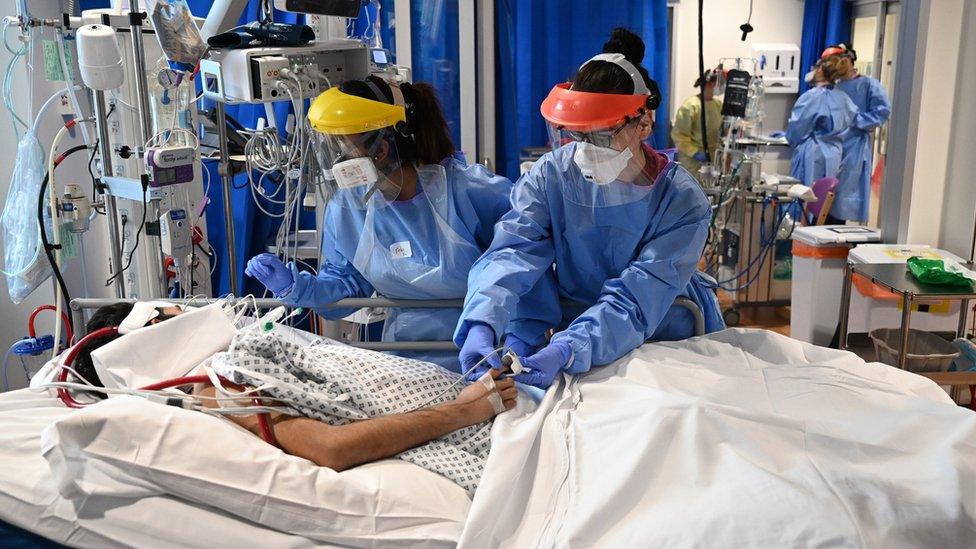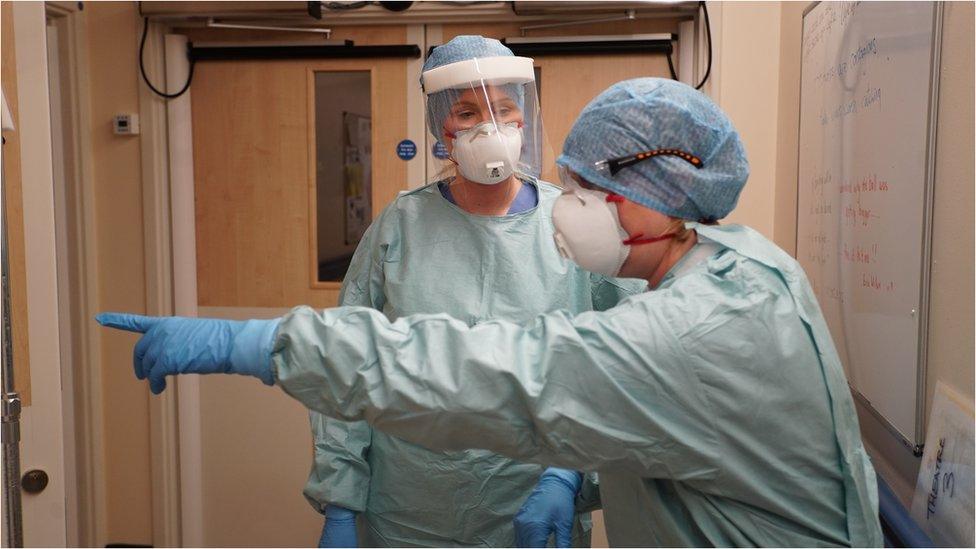Covid death figures: 10 things we've learned
- Published

More than 13,000 people are being treated for Covid-19 in hospitals around Britain
The National Records of Scotland has released its annual statistics on population, external, including a special analysis of the effect of Covid-19. Here are 10 things we've learned:
The average age of those who died with Covid-19
The average age at death for those who died with Covid-19 in Scotland was 79 for men and 84 for women. Elsewhere in the NRS report it showed that life expectancy in Scotland is 77.1 for males and 81.1 for females.
The report says the age profile of those dying with Covid was significantly older than that for deaths in general.
More than three quarters (77%) of all those who died were aged 75 or over and 43% were aged 85 or over.
This compared with overall deaths in 2019 where 63% were aged 75 or over and 33% were aged 85 or over.
The NRS figures use the wider measure of coronavirus deaths which includes all those where Covid-19 is mentioned on the death certificate.
Men are more likely to die with Covid
Statistically this is an odd one. More women (2,133) have died with covid on their death certificate than men (2,098)
However, the NRS report says that males are 1.4 times as likely to die than females.
There are fewer men in the older age groups (over 75) so their deaths account for a larger proportion of the male population.
Excess deaths spiked in April
In the early part of this year, the number of deaths was lower than the five-year average, meaning there were no excess deaths.
In April, excess deaths began to increase rapidly and continued to be above average until mid-June, after which point they returned to the average levels.
The report says there have been 4,306 more deaths registered than would have been the case if numbers were similar to the average over the past five year years.
How does Scotland compare with other countries?

The National Records of Scotland report cites ONS analysis comparing excess mortality rates between European countries covering the period from January to mid-June.
The analysis found that Scotland had the third highest excess mortality rate in Europe, behind England and Spain.
By mid-June, Scotland's age-standardised mortality rate for the year to-date was 5.1% higher than the five-year average. Spain was 6.0% above average and mortality in England was 7.6% higher.
People in large urban areas more likely to die
The age-standardised rate for deaths involving Covid in large urban areas (116 deaths per 100,000 population) was over four times that in remote rural locations (27 per 100,000 population).
The gap was substantially smaller when considering the rate of deaths from all causes (1.3 times as high in large urban areas compared to remote rural areas).
West Dunbartonshire was hardest hit by deaths from Covid
West Dunbartonshire has had the highest age-standardised death rate of all council areas with 314.3 deaths per 100,000 population.
This was closely followed by Midlothian (294.3), Glasgow City (291.0) and Inverclyde (280.0).
Highland (37.5), Moray (40.4) and Dumfries and Galloway (50.1) had the lowest rates (Orkney, Shetland and the Western Isles were excluded as the numbers were too low to calculate).
After adjusting for age, people in West Dunbartonshire were eight times as likely to die compared to those in Highland.
Deprived areas badly affected
People in the most deprived areas were over twice as likely to die as those in the least deprived areas, the report says.
It says there was a clear pattern when analysing by areas of multiple deprivation.
Age-standardised rates in the most deprived fifth of the population (124 per 100,000 population) are more than double those in the least deprived (59 per 100,000).
Factory workers most at risk

Additional hygiene measures were put in place after an outbreak at a factory in Angus
The numbers of deaths among working people in the 20-64 year old group were small, 6% of all Covid deaths up to the end of August.
The NRS report says a "broad analysis" by occupation group identified that those working as "process, plant and machine operatives" had the highest age-standardised death rate with 25.8 deaths per 100,000 people.
This group covers occupations whose main tasks involve operating and monitoring industrial plant and equipment, assembling products from component parts as well as those driving and assisting in the operation of transport vehicles and other mobile machinery.
It was the only major group which had a significantly different rate to the average rate for all occupations (10.3 per 100,000 people).
An analysis of health care workers and social care workers had relatively small numbers involved and concluded death rates for these two groups were not significantly different from the average.
Most people who died had a pre-existing condition
Of all Covid deaths occurring between March and August, only 8% had no pre-existing condition.
Of the 92% who did have a pre-existing condition recorded on the death certificate, the most common were dementia and Alzheimer's disease (31%); Ischaemic heart disease (13%) and Chronic lower respiratory diseases (11%).
More deaths in care homes than average

46% of Scotland's coronavirus deaths have occurred in care homes
In 2019 almost half (48%) of deaths from all causes took place in hospitals, a quarter (24%) in care homes and 28% at home.
In the first four weeks of the pandemic almost two-thirds (62%) of Covid deaths took place in hospitals.
However, between 13 April and 14 June the pattern changed as more than half (53%) of Covid deaths occurred in care homes.
From mid-June onwards there have been slightly more Covid deaths in hospitals, although the number of deaths was much lower in this period.
Over the course of the whole pandemic the proportion of Covid deaths has been similar in both care homes and hospitals (47% in hospitals and 46% in care homes) with only 7% occurring at home.
2019 population statistics
The National Records of Scotland's Population report, external provided figures for last year, including:
Scotland's population was at a record high at 5.46 million.
The lowest number of births were recorded since records began in 1855, with fewer than 50,000 registered.
The number of marriages registered was also at an all-time low of just over 26,000.
Deaths have outnumbered births for the fifth consecutive year, meaning the recent population increase is due to migration.
The number of households is growing faster than the population, with 1 in 5 people now living alone.
Life expectancy was improving for decades, but has changed very little in the last five years.